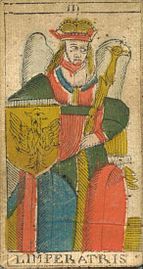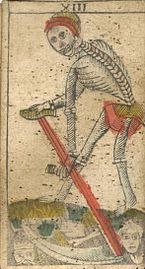
The Tarot de Besançon, also called the Besançon Tarot, describes an historical type of Tarot pack used for playing card games that was made in south Germany, France and Switzerland, including the town of Besançon.
History
The Tarot de Besançon was derived from the older form of the Marseille type, now known as ‘Type-I Tarot de Marseille’, compared with which it portrays characteristic differences, notably that the Popess (trump II) and the Pope (trump V) are replaced by, respectively, Juno and Jupiter. The earliest cards of this pattern came from Strasbourg in the early 18th century. During the mid-18th century other sources of manufacture included Colmar, Konstanz, Ulm and Munich, but the majority were manufactured in Alsace. The packs take their name from the eastern French town of Besançon, to which the cardmakers moved their production in the early 19th century. The so-called Tarot de Besançon was superseded in the late 18th century by French-suited tarot packs. The Swiss Tarot pattern, which emerged in Diessenhofen around 1860, was derived from the Tarot de Besançon.
Description
Typical of card packs of the Besançon type is that the cards traditionally depicting the Papess and the Pope were redesigned to portray the Roman gods, Juno and Jupiter. It is assumed that this renaming took place in order to avoid upsetting religious sensitivities in an area of distribution marked by confessional contrasts.
Other features of the Besançon type compared with the Marseille Tarot are:
- Cupid is aiming at the eyes of the lovers.
- The face of the Moon appears head on and not in profile.
- The world is not depicted dancing, but standing in contrapost.
Known manufacturers of card packs of this type are:
- Jean-Baptiste Benois
- Suzanne Bernardin
- J. Blanche, Besançon
- J. H. Blanck et Tschann
- Louis Carey, Strasbourg
- Andreas Benedict Göbl
- Arnoult Grimaud
- François Héri
- Jean Jerger, Besançon
- A. Kirchner, Besançon
- Joseph Krebs, Freiburg
- L. de Laboisse, Strasbourg
- Pierre Lachapele
- Nicolas François Laudier, Strasbourg
- Jean Pierre Laurent
- Arnoult Lequart
- Guillaume Mann, Colmar
- Johann Pelagius Mayer, Constance
- Renault, Besançon
- Bernhard Schaer, Mumlisweil
- Jean Tissot
- Wolfgang Weber
- Johannes Muller, Schaffhousen
- Josef Rauch Miller, Salzburg
The Besançon Tarot includes the Tarot 1JJ, which forms its own sub-type (see details in that article), and the Tarot d’Épinal, which also has specific variations in design. It was manufactured around 1830 or 1850 by the cardmaker, Pellerin, in Épinal, the wood engraving comes from François Georgin (1801–1863). Among the features are an additional card with the title, Consultant, which was clearly used as a Significator, which is why it may be assumed that the cards were also used for divinatory purposes and not, like other packs of this type at that time, used exclusively for playing cards.
The pictures below, showing the 22 trump cards, come from a pack with coloured wood carvings produced by Renault from Besançon around 1820–1830. The pack is based on a c. 1800 design by Jean Jerger, also from Besançon.
-
 The Fool
The Fool
-
 The Magician
The Magician
-
 Juno
Juno
-
 The Lady
The Lady
-
 The Lord
The Lord
-
 Jupiter
Jupiter
-
 The Lovers
The Lovers
-
 The Wagon
The Wagon
-
 Justice
Justice
-
 The Hermit
The Hermit
-
 The Wheel of Fortune
The Wheel of Fortune
-
 Power
Power
-
 The Hanged Man
The Hanged Man
-
 Death
Death
-
 Moderation
Moderation
-
 The Devil
The Devil
-
 The Tower
The Tower
-
 The Star
The Star
-
 The Moon
The Moon
-
 The Sun
The Sun
-
 Judgement
Judgement
-
 The World
The World
References
- Besançon Tarot by Jacob Jerger at wopc.co.uk. Retrieved 19 December 2023.
- ^ Pattern Sheet 6 - The Tarot de Besançon at the IPCS website. Retrieved 9 Jun 2019.
- For these two types, see Thierry Depaulis, “The ‘Tarot de Marseille’ – Facts and Fallacies”, The Playing-Card, Vol. 42, no. 1, July-Sept. 2013, pp. 23-43 and Vol. 42, no. 2, Oct.-Dec. 2013, pp. 101-120.
- Thierry Depaulis, The Cardmakers of Alsace, IPCS, 2023, chapter “The ‘Tarot de Besançon’, an ‘Ecumenical’ Tarot?”, pp.164-174
- Giordano Berti, "Tarot of Besançon of Josef Rauch Miller", in Tarot in German countries from the 16th to the 18th century, OM Edizioni, Quarto Inferiore 2018, pp. 23-25
Literature
- Dummett, Sir Michael (1980). The Game of Tarot: From Ferrara to Salt Lake City. London: Duckworth.
- Graf, Eckhard (1991). Lexikon des Tarot sowie der Orakel- und Selbsterfahrungsspiele. Nagelschmid, Stuttgart 1991, ISBN 3-927913-03-0.
- Mann, Sylvia (1990). All Cards on the Table, Jonas Verlag/Deutsches Spielkarten-Museum, Leinfelden-Echterdingen
- Rodik, Belinda (2008) Tarot-Lexikon. Grundbegriffe und Schlüsselworte zu Symbolik und Deutung. Schirmer, Darmstadt 2008, ISBN 978-3-89767-612-1, pp 323–346.